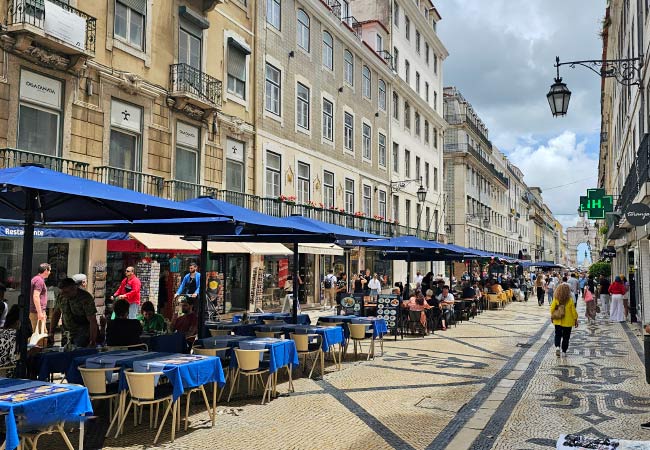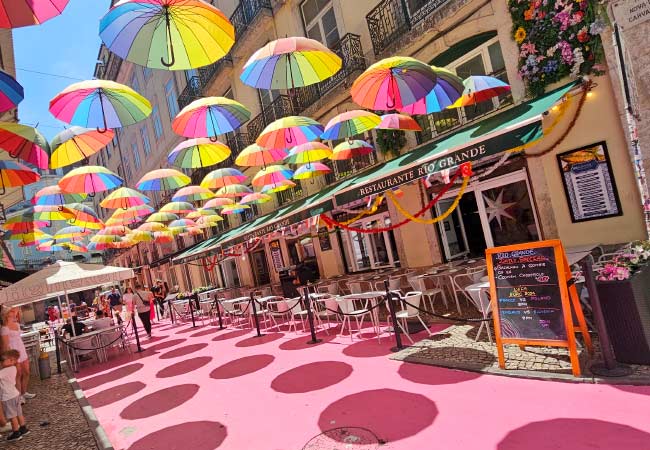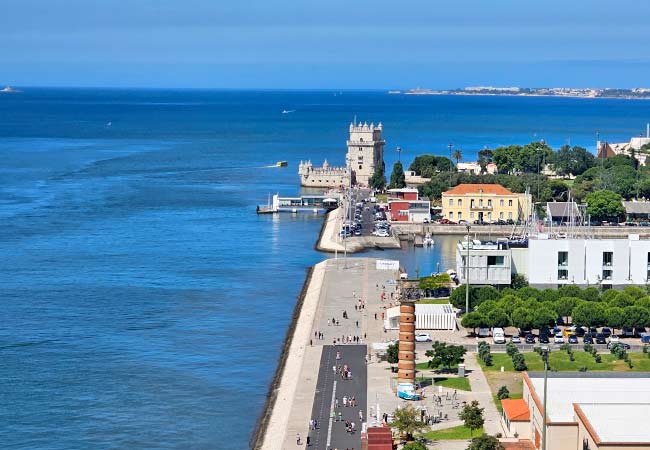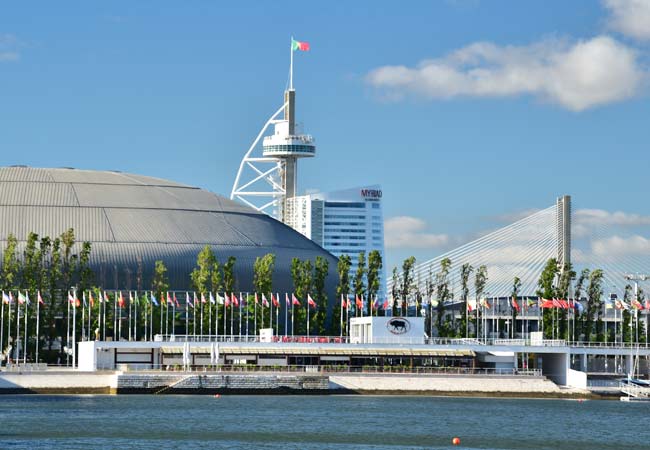LisbonLisboaPortugal.com
The best independent guide to Lisbon
LisbonLisboaPortugal.com
The best independent guide to Lisbon
Lisbon’s Hills - Is Lisbon walkable?
Lisbon extends across seven hills but is a very walkable city, as long as you are prepared to contend with some steep slopes.
The compact layout of Lisbon means exploring on foot is often the best option for sightseeing. However, the narrow, cobbled streets and many steep inclines can make it challenging for those with limited mobility or reduced fitness.
While sightseeing, you will feel as if you are constantly climbing or descending these hills. With a little planning, it is possible to create a route that avoids the hills entirely, staying within the valleys and following the banks of the Tejo Estuary.
For a first trip to Lisbon, the main tourist area is relatively compact, covering the Baixa, Alfama, and Cais do Sodré districts. This area can feel much larger, however, due to the maze-like streets of the Alfama district, in which it is easy to get lost. The popular Belém district is another key tourist area and is a short tram ride to the western side of the city.
The hills and cobbled streets make sturdy walking shoes essential. High heels can be particularly dangerous on the uneven surfaces, and while flip-flops may be tempting in the summer, they are not recommended for exploring the city.
If you prefer not to explore the city on foot, there are many alternatives, including tour buses, tuk-tuks, river cruises and the traditional trams. Lisbon has excellent public transport, with a modern metro and extensive bus routes. Ride-hailing apps (such as Uber or Bolt) are also inexpensive and often provide the most convenient way to travel around the city.
Insight: Don't let Lisbon's famous hills put you off from visiting. The city is very accessible for visitors with limited mobility, offering many flat districts to explore and excellent transport options to bypass the steepest climbs.
How to Avoid the Hills: Exploring Lisbon’s Flatter Districts
While Lisbon is a hilly city, several key districts are almost entirely flat, making them ideal for visitors with mobility concerns or for anyone wanting a relaxed day of sightseeing.
The Baixa District - Situated in a valley between the hills of Alfama and Bairro Alto, Baixa is the flat heart of Lisbon. The district extends northwards from the banks of the Tejo estuary and is perfect for easy exploration, with its grid of grand plazas and wide, pedestrian-friendly avenues. To the north, Baixa is adjoined by the Avenida da Liberdade, a gently sloping boulevard lined with high-end hotels. This makes the area a strategic choice for accommodation if you wish to avoid steep inclines.

The Rua Augusta at the heart of the Baixa district
The Tejo Riverfront and Cais do Sodré - The banks of the Tejo estuary offer a long, continuous flat route. A walk west from the centre leads to the Cais do Sodré district, home to the popular TimeOut food market and the lively Pink Street. Following the riverbank east allows you to skirt the base of the Alfama district, passing the cruise terminal. This path provides a way to see the edge of Alfama without having to tackle its steep hills.

Pink Street in Cais do Sodré
The Belém District - Further west from the city centre, the Belém district is another significantly flat area rich with important monuments. Here you will find the Mosteiro dos Jerónimos, the Torre de Belém, and the original home of the Pastéis de Nata, Pastéis de Belém. While not connected by the metro, Belém is easily reached by Uber/Bolt or the E15 tram, though be aware that the tram can become extremely crowded.

Belem waterfront
Have you booked your hotel yet?
During the peak season, demand for hotels and accommodation in Lisbon is very high. It is recommended that you book your accommodation as early as possible to secure the best prices.
The map below shows the location of hotels and rental rooms in Lisbon. By altering the date to suit your trip, the map will display current availability and prices:
The Hilliest Areas: Where You Will Feel the Climb
For most visitors, Lisbon's steepest inclines are experienced when climbing out of the central Baixa valley. The two most challenging areas are the districts of Alfama and Bairro Alto, which rise up on either side.
Bairro Alto and Chiado - To the west of Baixa, a significant climb is required to reach the districts of Chiado and Bairro Alto. The streets leading up from Baixa or Cais do Sodré are consistently steep, and you will certainly feel the effort. Once at the top, however, the districts themselves are relatively flat, making the initial climb worthwhile.
The Alfama District - While Bairro Alto's hills are challenging, Alfama often feels like the hilliest part of Lisbon. The district is a dense maze of narrow, winding alleys that constantly twist up and down the side of the hill leading to the castle. Its compact and disorienting layout means you are almost always on a steep gradient, making it the most physically demanding district to explore purely on foot.

Yet more steps in Alfama
Lisbon’s Beautiful but Treacherous Calçada Pavements
A defining feature of Lisbon is its decorative ‘Calçada Portuguesa’, the traditional mosaic pavements found throughout the city. These are crafted from black basalt and white limestone stones, creating intricate patterns that are beautiful to admire.
While visually striking, these historic pavements present distinct challenges for walkers. Firstly, the limestone stones have been polished smooth by centuries of footfall, making them notoriously slippery, especially during the wet winter months (typically November to February). Secondly, on older streets, individual stones can become loose or dislodged over time, creating an uneven and unpredictable surface.
These conditions make sturdy, flat-soled footwear with good grip essential. High heels should be avoided entirely; the narrow heel can easily become wedged in the gaps between stones, leading to a fall or twisted ankle on the already uneven ground.

Rossio plaza, with its distinctive tiled pavements
How to Get Around Lisbon and Navigate the Hills
While Lisbon's centre is compact, you will need to use transport to avoid the most strenuous climbs or to visit outlying districts like Belém.
Ride-Hailing Apps (Uber and Bolt)
For most visitors, ride-hailing apps like Uber and Bolt offer the best combination of convenience and cost. They are consistently cheaper than traditional taxis and provide a direct, door-to-door service, which is ideal when you want to bypass a long uphill walk. It is advisable to download and set up one of these apps before you begin sightseeing.
Public Transport - The 24-hour
Lisbon has a highly efficient public transport network. For those planning to use it multiple times in a day, the 24-hour ticket offers exceptional value at approximately €6.60. This ticket, which can be purchased from any metro station, provides unlimited travel on the metro, buses and trams.
The Metro
Lisbon’s metro is modern and reliable, and it is the best way to travel from the airport to the city centre. However, its usefulness for sightseeing is limited, as the network does not have stations in the key tourist areas of Alfama or Belém.
Trams
The city's charming, historic trams are an iconic way to navigate the narrow streets of the older districts. The famous number 28 tram route is particularly useful for sightseeing, as it connects many popular areas by tackling the steep gradients and sharp turns that are inaccessible to larger vehicles.
Tuk-Tuks
Throughout the tourist areas, you will be offered rides in tuk-tuks. While these can be a fun way to see the sights on a guided tour, they should not be considered a practical mode of transport. A ride in a tuk-tuk will be significantly more expensive than an equivalent journey by taxi or Uber.

The 28 tram in front of the Basílica da Estrela
Should You Rent a Car for Lisbon?
A rental car is not recommended for any visit focused on Lisbon itself. The narrow, historic streets are frequently congested, and parking in the central districts is both scarce and expensive. Navigating the city by car is a significant challenge and will likely be more of a hindrance than a help.
A vehicle only becomes an asset when you begin to explore the wider Lisbon region. If your itinerary includes day trips to coastal towns like Cascais or into the countryside, it is advisable to rent a car only for the specific days you plan to travel outside of the city. For your time in Lisbon, a car is unnecessary.

Parque das Nações is the modern side of Lisbon
Discover more of Lisbon with our most popular guides
If you've found our content valuable, we'd welcome your support.
The digital publishing landscape has evolved significantly. As a small independent publisher, we face growing challenges. Search engines increasingly favour paid content over organic results, while AI-generated content often reproduces original work without attribution.
To support our work, please consider bookmarking this page (press Ctrl + D) for quick access. If you find an article helpful, we'd be grateful if you'd share it with friends on social media.
For specific questions, please see our Reddit community at r/LisbonPortugalTravel.
Should you notice any outdated or incorrect information, please contact us at [email protected]
Thank you for helping us continue to provide valuable content in an increasingly challenging digital environment.
A complete list of all of our Lisbon articles
If you've found our content valuable, we'd welcome your support.
The digital publishing landscape has evolved significantly. As a small independent publisher, we face growing challenges. Search engines increasingly favour paid content over organic results, while AI-generated content often reproduces original work without attribution.
To support our work, please consider bookmarking this page (press Ctrl + D) for quick access. If you find an article helpful, we'd be grateful if you'd share it with friends on social media.
For specific questions, please see our Reddit community at r/LisbonPortugalTravel.
Should you notice any outdated or incorrect information, please contact us at [email protected]
Thank you for helping us continue to provide valuable content in an increasingly challenging digital environment.



































